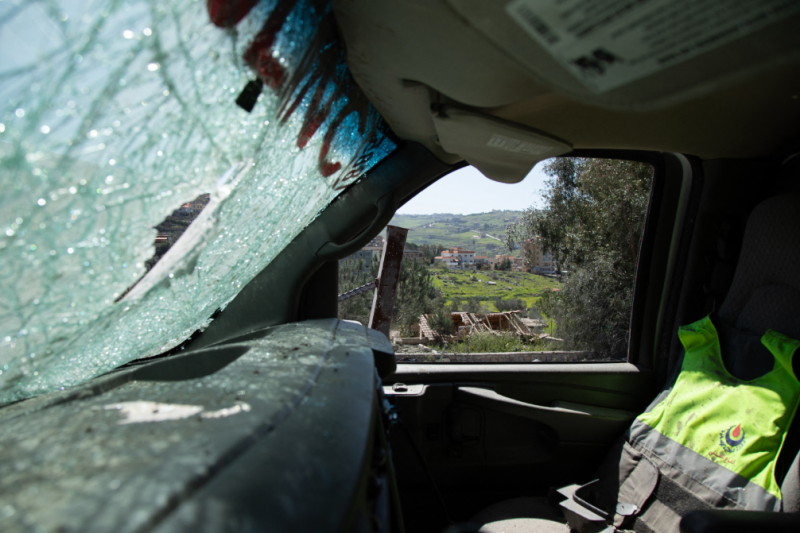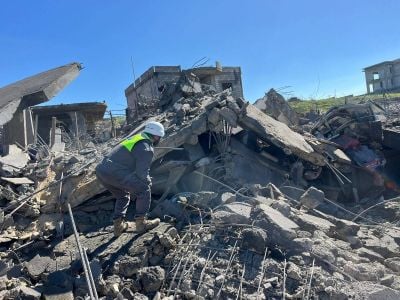
A damaged ambulance remains at the site of an Israeli airstrike a day earlier in the southern Lebanese village of Adaisseh near the border with Israel on March 5, 2024. (Credit: Hassan Fneich/AFP)
On Monday evening, for the third time since cross-border fighting began between Israel and Hezbollah, a medical facility in southern Lebanon was targeted, killing three paramedics. The vast majority of first responders in southern Lebanon are members of medical organizations run by Hezbollah and its ally the Amal Movement.
The Israeli attack targeted a civil defense center in Adaisseh, the third strike of its kind — on Jan. 11, an Israeli attack on a center in Hanine killed two first responders and on Feb. 22, an attack killed another two rescue workers.
The Lebanese Health Ministry released a statement Monday saying that it will not "turn a blind eye" to the Israeli army's “persistence in repeating attacks on healthcare centers [and] ... these crimes committed by the occupying forces since the beginning of their aggression in the South."
According to the statement, there have been seven killed and ten wounded within Hezbollah's Islamic Health Association and the Amal Movement's al-Rissala Mission Scouts, since cross-border fighting began. Seventeen ambulances have been destroyed or damaged by the fighting.
What are these organizations and what role have they played in the South, before and during the ongoing conflict?
The Hezbollah press office told L’Orient-Le Jour last week that its civil defense workers juggle several roles. "We carry out search-and-rescue operations, as well as clearing, rescuing and transporting the killed and injured. We also offer burial services, funeral arrangements and even follow-up care for internally displaced persons,” a spokesperson said.
The Islamic Health Association claims to have mobilized 56 teams and 155 vehicles (including ambulances and fire engines) since the start of the border conflict, to respond to the various ramifications of fighting in affected areas. Hezbollah’s fire-fighters are also said to have intervened on several occasions to "extinguish fires started by the white phosphorus bombs used by Israel" in the South.
Hezbollah established the Islamic Health Association in 1984, two years after the party itself was founded. According to the association's official website, the medical organization was created "in light of the tragic circumstances experienced by the Lebanese people as a result of the Lebanese Civil War."
The website states that in 1988, the association received a license for its activities from the Ministry of the Interior. Initially organized for basic first aid rescue operations during the war, the association eventually set up several hospitals and medical facilities in various regions in Lebanon.
The first goal listed in the association's mission statement reads: "Serving the vulnerable and disadvantaged, especially those living in poor and remote areas, and who are miserable and neglected by the Lebanese state in regards to health and social standards."
Hezbollah says the association now has 100 offices around the country and its operations are run by 4,000 men and women, most of them volunteers.
The al-Rissala Scouts Association was founded by the Amal Movement in 1982, with similar intentions “to respond to needs on the ground,” during the devastating Lebanese Civil War.
Its volunteers are said to have helped bury the majority of victims of the Sabra and Shatila massacres, according to Mohammad Arandas, the organization’s spokesperson.
Arandas says the association has carried out about half of the rescue operations in southern Lebanon since the start of the war.
Well-coordinated and deeply rooted in the area, the two health organizations are capable of functioning in the south with significant efficiency.
The National Civil Defense, which is present throughout the country, often finds itself on the ground with Hezbollah and Amal volunteers, but it operates alone in areas along the Blue Line, just a few steps from the border with Israel.
"In Arkoub and in parts of Marjayoun district, not far from the front line, the Health Association and al-Rissala Scouts have no presence there," says Hussein Fakih, director of National Civil Defense in the Nabatieh district, southern Lebanon. "National Civil Defense has 13 offices in the regions south of the Litani River and in the area close to the Blue Line, from Arkoub [a predominantly Sunni region that includes the towns of Shebaa and Kfarchouba] to Aita al-Shaab," he told L’Orient-Le Jour.
When asked about coordination between the various medical organizations, Fakih said that as a state body, “the National Civil Defense only coordinates with the Lebanese Army.”
"We are attached to the Lebanese authorities, whereas other rescue workers are affiliated to political parties. So everyone makes their own decisions.”

